MIPI DSI Receiver IP
Filter
Compare
25
IP
from
11
vendors
(1
-
10)
-
DSI Receiver Controller
- The DSI v1.3 Receiver Controller IP is designed to provide MIPI DSI 1.3 compliant high-speed serial connectivity for device (mobile display modules) with Type 1 to 4 architectures.
- Serial connectivity to the mobile applications processor’s DSI host is implemented using 1 to 4 D-PHY’s (also available from Arasan), depending on display bandwidth needs.
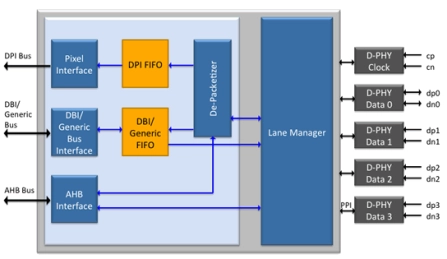
-
MIPI DSI v2.2 Verification IP
- Compliant to MIPI DSI Specification version 2.2 and MIPI C-PHY Specification version 2.1 with PPI interface.
- Support all Calibration Format & operations
- C-PHY supports MFAA and SFAA for DSI TX and RX respectively for Data Lane Module in command mode.
- C-PHY supports MFAN and SFAN for DSI TX and RX respectively for data Lane Module in video mode.
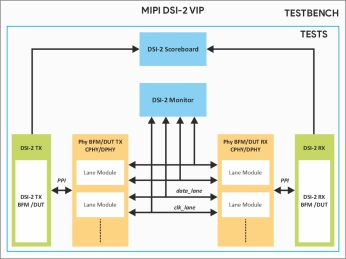
-
MIPI DSI v1.3.2 Verification IP
- Compliant to MIPI DSI Specification version 1.3.2 and MIPI D-PHY Specification version 1.2 with PPI interface.
- Support all Calibration Formats & operations
- D-PHY supports MFAA and SFAA for DSI TX and RX respectively for Data Lane Module in command mode.
- D-PHY supports MFAN and SFAN for DSI TX and RX respectively for Data Lane Module in video mode.
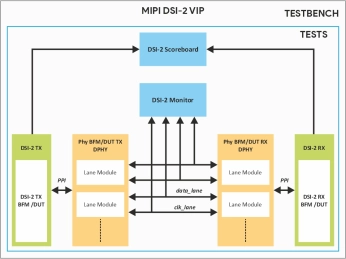
-
MIPI DSI Verification IP
- Full MIPI DSI Transmitter and Receiver functionality.
- Supports 1.3.1 MIPI DSI/2.0 MIPI DSI-2 Specifications.
- Supports PPI interface.
- Operates as a Transmitter, Receiver, or both.

-
MIPI DSI Synthesizable Transactor
- Full MIPI DSI Transmitter and Receiver functionality.
- Supports MIPI DSI v1.3 and MIPI DSI-2 v1.1 Specifications.
- Supports PPI interface.
- Operates as a Transmitter, Receiver, or both.
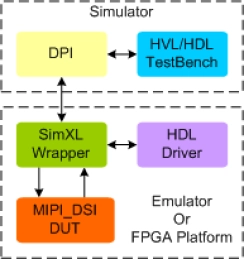
-
MIPI DSI-2 Receiver IIP
- Compliant with MIPI DSI-2 specification v1.3
- Compliant with D - PHY Specification v1.1,v1.2,v2.0,v2.1
- Compliant with C - PHY Specification v0.7,v1.2
- Compliant with Display Pixel Interface (DPI -2) v 2.0
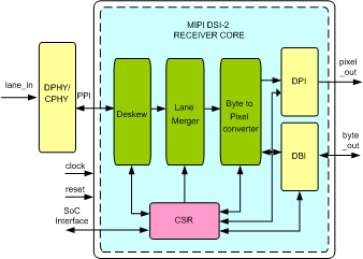
-
MIPI D-PHY RX+ (Receiver) IP
- The MIPI® D-PHY RX+ is a proprietary implementation of the MIPI Camera Serial Interface 2 (CSI-2) and Display Serial Interface (DSI) D-PHY Receiver.
- It is optimized to achieve full-speed production testing, in-system testing, and higher performance compared to traditional configurations, while reducing area and standby power.
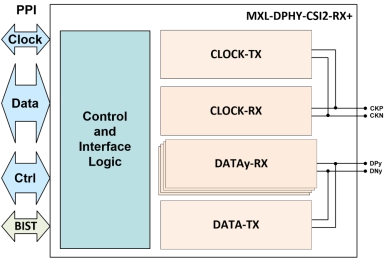
-
MIPI D-PHY/LVDS Combo Receiver IP
- The MXL-LVDS-MIPI-RX is a high-frequency, low-power, low-cost, source-synchronous, Physical Layer that supports the MIPI® Alliance Standard for D-PHY and compatible with the TIA/EIA-644 LVDS standard.
- The IP is configured as a MIPI slave and consists of 5 lanes: 1 Clock lane and 4 data lanes, which make it suitable for display serial interface applications (DSI).
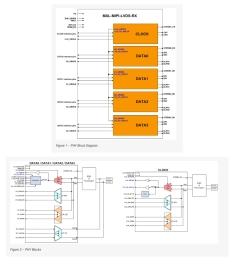
-
MIPI D-PHY TX & RX + DSI & CSI Controllers
- Compliant with MIPI Committee Specifications
- High Data Rates: Supports data transmission rates up to 4.5Gbps per lane, allowing for high-resolution displays and smooth refresh rates
- Energy Efficiency: Optimized for low power consumption, making it ideal for battery-powered devices
- Complete Display Solution: Combines the MIPI D-PHY Transmitter PHY and DSI Controller to make it a one-stop solution
-
MIPI CD PHY Combo TX & RX + DSI & CSI Controller
- Our MIPI CD-PHY Transmitter and receiver PHY with Display Serial Interface (DSI) and Camera Serial Interface (CSI) Controllers are tailored for high-performance display and camera interface applications.
- These two PHY (TX and RX) integrated systems ensure seamless communication between the processor and display, the processor and camera; supporting high data rates and efficient power consumption.